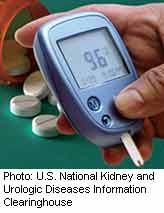
MONDAY, March 23, 2015 (HealthDay News) — When caring for people with diabetes, primary care doctors need to tailor blood sugar targets and treatments to the individual patient, new recommendations suggest.
That’s just one of the guidelines highlighted in an article that experts from the Joslin Diabetes Center in Boston published in the March 23 issue of the Annals of Internal Medicine.
The article summarizes important changes in the American Diabetes Association’s (ADA) 2015 Standards of Care guidelines, which include screening Asian-Americans for diabetes at lower weights and giving statins to anyone with diabetes who is over 40.
“This extends the opportunity for primary care physicians who see the bulk of patients with diabetes to be exposed to the guidelines. We choose three areas from the guidelines we thought needed highlighting,” said senior author Dr. Martin Abrahamson, senior vice president and medical director of the Joslin Diabetes Center.
One of the important areas in the ADA’s guidelines is the need to consider patients as individuals and tailor treatments accordingly. Age, other medical conditions, life expectancy, as well as the patient’s motivation and preferences all need to be considered when choosing therapies and setting blood sugar goals, according to the authors of the article.
Metformin is generally the first drug of choice in type 2 diabetes. If metformin fails to control blood sugar levels, it’s not always clear what the best drug choice would be. However, there are currently ongoing studies trying to answer that question, noted Abrahamson and his colleague, Dr. Giulio Romero.
“An A1C of under 7 is still the general recommendation, unless you’re someone who’s older or has more complications. The good news for many people is that there are many more drugs that can be used that do not cause hypoglycemia [dangerously low blood sugar] that make it easier to reach the A1C target,” Abrahamson said.
A1C is a blood test that estimates average blood sugar levels over two to three months. Previous research has shown that keeping A1C levels below 7 is associated with a lower risk of diabetes complications.
A second issue the authors noted is that Asian-Americans start developing diabetes at lower weights. “Overweight and obesity are not one-size-fits-all. If you’re Asian-American, a body mass index (BMI) of 23 is overweight,” Abrahamson said.
Body mass index is a rough estimate of body fat that is based on height and weight. In general, a BMI of 25 is considered overweight, according to the U.S. Centers for Disease Control and Prevention.
The authors said the reason Asian-Americans have a greater risk of diabetes at a lower weight is because their fat tends to deposit around their internal organs. This is known as visceral fat, and it increases the risk of insulin resistance, a precursor to type 2 diabetes. For this reason, the ADA recommended that type 2 diabetes screening in Asian-Americans should start if their BMI is 23 or higher, rather than at 25.
The final recommendation highlighted dealt with heart disease risk. People with both type 1 and type 2 diabetes have a significantly increased risk of developing heart disease. Because of this, the ADA recommended that doctors should begin cholesterol-lowering medications called statins in anyone over 40 with diabetes, even if they don’t have high cholesterol.
“If you have diabetes, you’re already at risk for heart disease. The ADA guidelines say if you have diabetes and you’re between 40 and 75, you should be on a statin,” Abrahamson noted.
Dr. Sam Altstein, a family medicine doctor and medical director of the Mount Sinai Beth Israel Medical Group in New York City, said none of the recommendations would be difficult to incorporate into practice.
“Doctors are very good at tailoring treatment to specific individuals. Patients don’t always fit into algorithms — they may be elderly or very sick — so, we have to make adjustments,” Altstein said.
Altstein said the biggest challenge in treating people with type 2 diabetes is that “when someone comes in with type 2, they often have 10 to 20 years of unhealthy living under their belt. It’s easy to figure out which medications they should be one, but getting people to change how they live is a lot like asking someone to change their religion. People have a hard time changing. It’s very hard to undo a lifetime of habits,” he said, adding that a referral to a dietician is often helpful.
He also recommended that patients “connect with your doctor and ask what your doctor feels a realistic goal is for you.” For example, someone who’s very overweight may not be able to lose 100 pounds, but they might feel 20 pounds is possible. “And, from a physiologic perspective, modest decreases in weight can lead to substantial changes in diabetes,” Altstein said.
More information
Learn more about the management of type 2 diabetes from the American Diabetes Association.
Copyright © 2025 HealthDay. All rights reserved.

